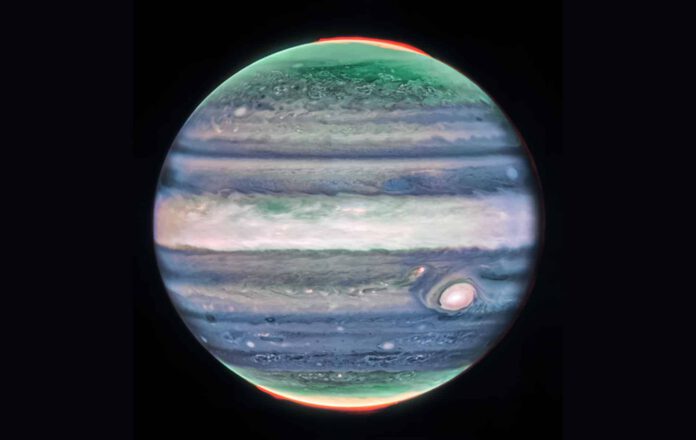
Scientists have identified a powerful jet stream blowing at a speed around 320 miles per hour. This velocity is twice as fast as the wind speeds of a Category 5 hurricane on Earth.
A closer look at Jupiter
Thanks to a range of telescopes and space missions, one might think that we’ve uncovered all of Jupiter’s secrets. The Great Red Spot, for instance — so colossal that it could completely cover the Earth — is almost as famous as certain rivers and mountains on our own planet. However, like the Earth, Jupiter undergoes constant changes and there is still plenty that we need to discover. Fortunately, we have the James Webb Space Telescope to help solve some of these mysteries. Recently, Webb has observed something remarkable on Jupiter, something never before detected.
The Jet Stream
In the scientific journal Nature Astronomy, researchers have reported that Webb has uncovered something entirely new in Jupiter’s atmosphere. It’s a swift jet stream that traverses the equator. Stretching over 2,982 miles, this stream is located above the planet’s primary cloud layers.
The jet stream rushes at a speed around 320 miles per hour, twice as fast as the sustained winds of a Category 5 hurricane here on Earth. It resides at an altitude of about 25 miles above the clouds, in an area known as Jupiter’s lower stratosphere.
Although the jet stream is not as visually striking or impressive as some other features of Jupiter, its discovery provides insights into how the layers of its famous turbulent atmosphere interact. Furthermore, the finding underscores Webb telescope’s unique ability to observe such features.
Surprise Discovery
Researchers are astounded by their discovery. “This has completely taken us by surprise,” says researcher Ricardo Hueso. “What used to be only hazy spots in Jupiter’s atmosphere are now shown as clear features that we can track.”
Observations and Analysis
The researchers stumbled upon the jet stream through the analysis of data captured by Webb’s NIRCam (Near-Infrared Camera) in July 2022. This was carried out as part of the Early Release Science program, which aimed to capture images of Jupiter at 10-hour intervals, mirroring a day on the gas giant. The team utilized four different filters, each capable of detecting changes in small features at various heights within the atmosphere.
“Despite various telescopes on Earth, spacecraft like Juno and Cassini, and the Hubble Space Telescope contributing to our understanding of the changing weather patterns in the Jovian system, the Webb telescope has already shed new light on Jupiter’s rings, moons, and atmosphere in a short period,” observes researcher Imke de Pater.
Infrared Observation
Webb’s keen infrared gaze is key. The Webb Telescope peers deeper than ever into the near-infrared range, enabling it to observe the upper layers of Jupiter’s atmosphere about 15 to 31 miles above the tops of the clouds. In near-infrared recordings, these higher layers often appear vague, with a brighter area above the equator. However, using the Webb Telescope, we can now observe more detailed features within this bright yet hazy area. This underscores the added value of the space telescope.
“It’s surprising that even after many years of observations of Jupiter from various observatories, we are still discovering new things about this planet,” states team member Leigh Fletcher. “The fact that features like this jet stream could remain hidden until the new NIRCam images were taken in 2022 is remarkable.”
Further Observations
The researchers look forward to further observations of Jupiter using the Webb Telescope to determine whether the velocity and altitude of the jet stream change over time. “While Jupiter has a complex, but predictable pattern of winds and temperatures in its equatorial stratosphere, there’s a possibility that the strength of this new jet stream is related to an oscillating stratospheric pattern,” Fletcher explains. “This could lead to significant changes in the jet stream in the next two to four years. It will be truly intriguing to see if this theory is confirmed in the coming years.”











